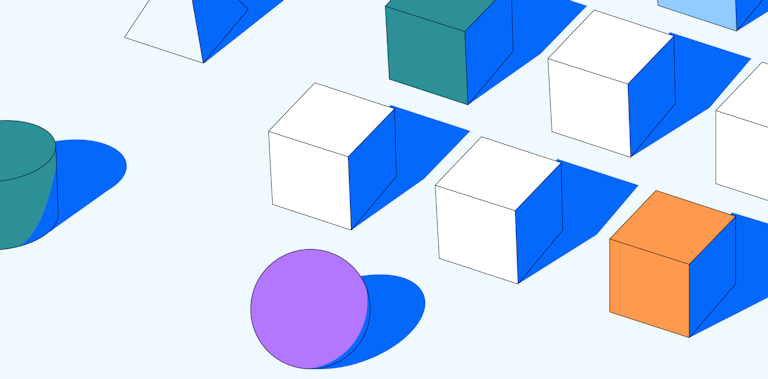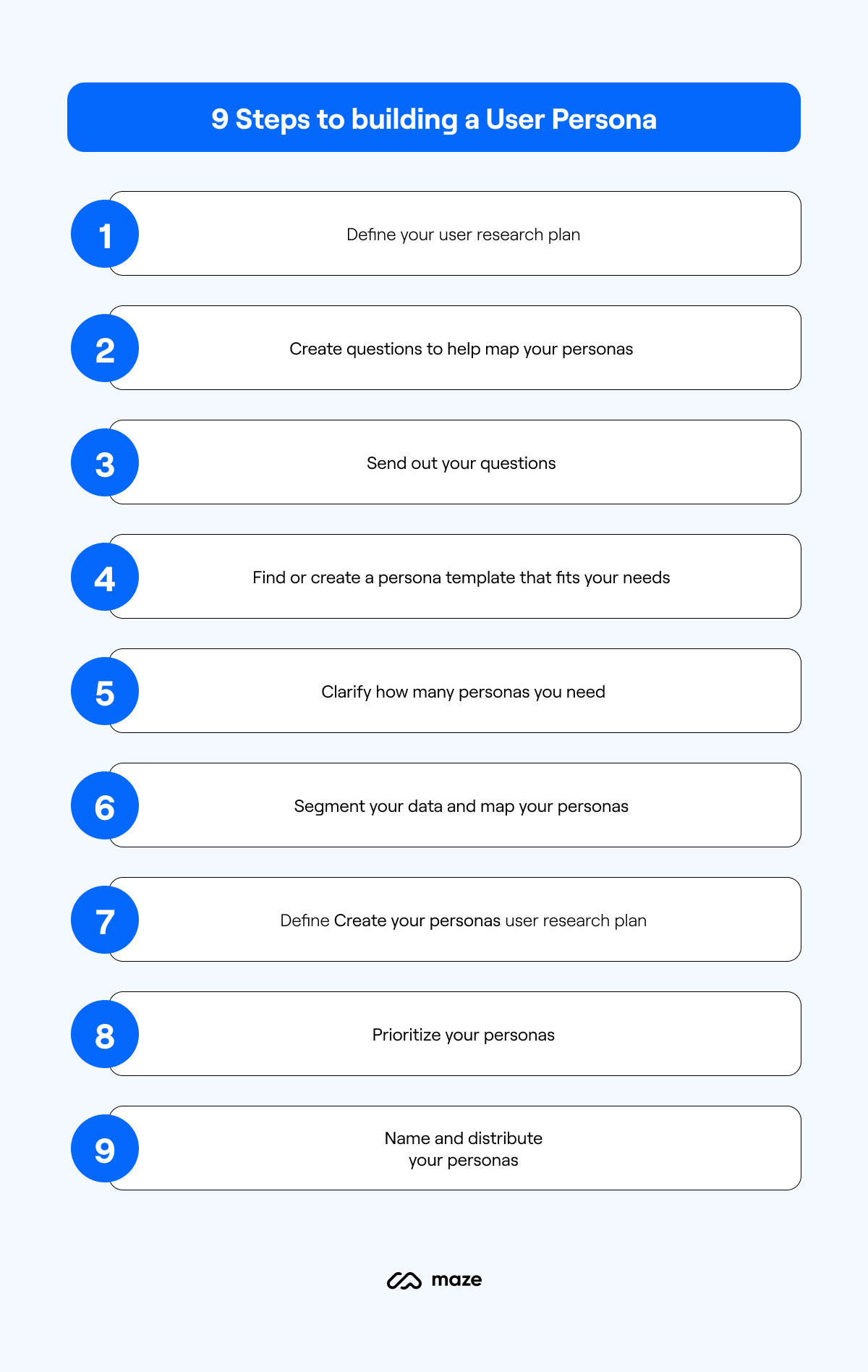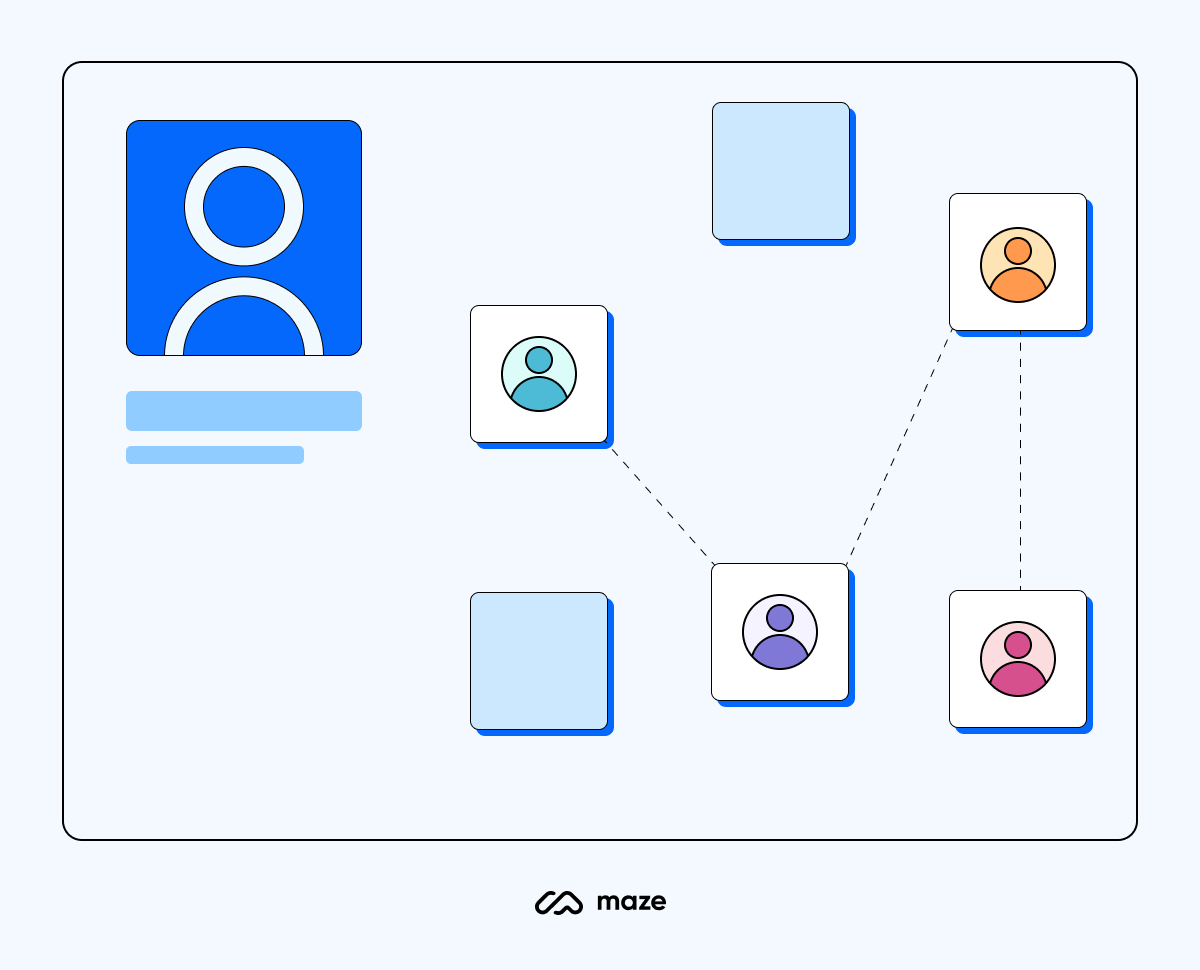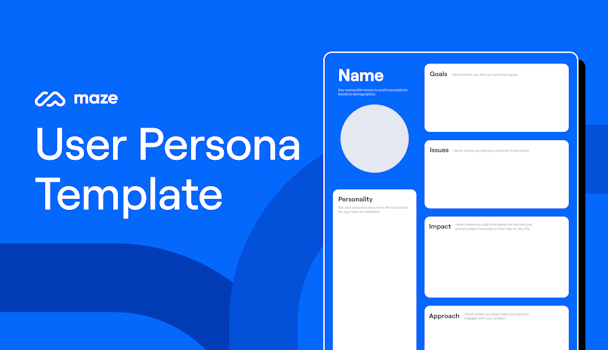Chapter 2
How to create UX personas: 9 steps to building personas
In this chapter we’ll explore how UX designers can create user personas in nine steps. From conducting user research to persona mapping to conducting and distributing your personas to ensure they remain effective.

User personas are a necessary user research step in order to deliver empathetic, inclusive, usable products. However, uncovering the process of how to create user personas is a challenging one. This chapter will break down how you can build user personas to hit your product-led growth goals and avoid user assumptions along the way.
We’re not our users, even if we’re adjacent to them.

Ash Oliver
Brand Experience Designer & Founder at Foster
Share
Put time on your calendar for user personas
Before we even begin on this path to creating useful user personas, UX designers and user researchers need to know that in order to create personas, you need to create time first.
Book some time in your calendars. You can conduct the process we’re about to share in a sprint, over the space of a week or two, or it can be something more gradual that you develop over time—over the course of a quarter, for example.
Consider your other business needs, and how you can (or already do) collect information from your target audience. Do you need to recruit research participants, or do you already have access to a user research group to help with this stage? The answer to this will help determine a realistic project timeline.
Lastly, let internal stakeholders know that the process of building buyer personas is not something that will see a return on investment (ROI) immediately for your business, it will also take time to realize.
Once you’ve mapped out your project timeline—including room to reap the results of implementing this valuable UX tool—you can begin your persona-building process. This process is broken down into three parts:
TL;DR
1. Phase one: User research
This UX research phase includes identifying your research resources, curating the right questions, collecting and collating that information, then organizing it well.
2. Phase two: Persona mapping
Once you’ve collected and organized your data, you can start to build your user personas. This phase includes identifying how many personas you need, which ones are most important to the growth of your product, further segmentation opportunities beyond the obvious, and how you’re presenting these personas so they’re actionable research tools for your team.
3. Phase three: Persona distribution
Lastly, once you’ve got everything together, it’s time to put these personas out there! Building personas is not a one-time operation. Your personas are something that need to be continuously revisited, reiterated, and redistributed among your teams to ensure they’re still providing value.
That’s our overview. Now, let’s get into building these user personas.

1. Define your user research plan
First up, you’ll want to set the goals of your personas. What are your business problems right now, and how are user personas able to solve them? These goals will help keep you on track through every step that follows.
User persona goals will help determine the kind of information you need to collect and display.
You’ll probably want to take all your current data points and user research, and throw it out of the digital window. However, there’s no need to take such a strong approach—some of your data may be valid or recent enough to support this research phase.
Equip yourself with the data sets you need, or establish where you can find them, before you start to build your user personas. Doing the above should give you a good idea of the amount of personas you’ll need to do your product justice and encompass every type of user.
Lastly, identify where you’re able to conduct this research. What avenues do you have available? Now’s a good time to create a stellar user research plan.
Consider existing customers, potential customers and prospects, referrals, and user research groups for your research groups.
2. Create questions to help map your personas
You’ll want to ask questions that truly showcase who your users are. We’re building archetypes, not stereotypes. Only rich questions are going to help flesh out your personas. Rich questions are questions that provoke thought, and generate in-depth qualitative responses you can spot trends in, build on, and learn from.
The top three things you want answering are:
- Who are they?
- What is their goal?
- What's their main barrier from reaching that goal?
Think of these three bulleted questions as chapters, and each will have its own subsections to help you further identify your personas.
Ash Oliver, Brand Experience Designer & Founder at Foster stressed the importance of these questions to gather contextual data.
“We’re not our users, even if we’re adjacent to them. For example, I’m a designer, but I’m just one designer. Context helps frame your understanding. The more context we have, the broader picture we can illuminate. It helps us get a better understanding of what daily life looks like for users.”
Ash goes on to explain the importance of rich, open-ended questions over closed questions focusing on quantitative data: “They weave in storytelling, to better allow UX designers to step into the minds of those users and experience the product from their point of view.”
How you get those answers is determined by the rich questions you put together and how they enable you to segment. This is such a crucial stage of your user research that it’s deserving of its own chapter. Jump ahead to explore how to create a persona map and further benefits of undergoing this process.
Examples of rich questions are:
- What are you currently using to get your job done? Why is it no longer serving you?
- What other challenges are you facing in your role that you need help with?
- What’s your profession and responsibilities?

3. Send out your questions
It’s important that no matter where you’re delivering your user research questions, you’re delivering the same question set, so every user goes through the same experience. This way, their answers are less likely to hold experience bias.
For example, you can’t take the responses of an Instagram poll as having the same weight as those that have completed a ten-minute survey. When creating personas, the slightest divergence in survey experience can impact the overall accuracy of your data.
It’s a good idea to target users by setting up an invite to your user research survey on a popular page, either in-app with a product modal, or on your website with a banner or modal.
Lastly, look at other resources you have: email, social media, Slack communities, or recruiting participants from a SaaS business providing user testing opportunities. If you already have a participant group in the works, then consider Maze to help you manage this feedback step.
4. Segment your data and map your personas
You’ve now sent all of your questions and can start collecting, organizing, and segmenting this data! Next, you’ll want to build a knowledge base of sorts to help organize your user personas. By doing this, you’ll be able to identify trends and turn qualitative responses into quantitative data points to help flesh out multiple personas.
It may sound old school, but the best tool to do this is Google sheets or Excel. If you’re not a whizz with either, this may be a good time to level up, or find the talent to manage this for you.
Read through your data, and start segmenting answers based on trending keywords—they’ll be easy to highlight and group in Excel or Google Sheets. From there, you can start sorting answers into sub-groups of those groups—this will help your next step.
Persona mapping 🗺
Jump ahead to chapter three for an in-depth runthrough on mapping personas.
5. Clarify how many personas you need
Keep repeating the above process until you've covered the large trends. If you still have a lot of ungrouped information, consider ways you can further segment: look for micro-communities within larger communities.
Even if this information doesn’t aid design, it can prove useful for other areas of your business, like your product marketing efforts, customer success teams and sales.
By the end of this step, you’ll have a clear idea of how many user personas you need to cover all your data trends. Try not to leave anything ungrouped, as you could potentially be missing a new persona opportunity.
There’s no right or wrong answer for the number of personas you need. Most businesses tend to go for three–five, however, that’s not to say this needs to be the case for you.
6. Find or create a persona template that fits your needs
Your research should not be dictated by how you’re going to display it. That’s why we introduce this stage later in the process. If you’re already collecting and segmenting your data with a specific template in mind you’ll be biased to the information you choose to collect and how you give it preference.
Once you’ve got your data sorted, look for a user persona template that can help you showcase what you want to put out to your business, and which areas of each persona need spotlighting.
There are a lot of templates out there for marketing personas that you can tweak for your own purpose. Or, jump to chapter four to learn how to create a user persona template in-house.
Download our free persona template 📝
More on this in chapter four, but to help you get started, we've put together this user persona template that's free to use and ready to go. Take a look over on Figma.

7. Create your personas
Now comes the fun part: it’s time to start building out each user persona that perfectly encapsulates your target audience. Start doing this with a very low-fi frame of mind, just get a few ideas onto paper for those predetermined groups of data.
Don’t worry about putting names to them yet, you’re more so looking for grouping principles that relate to each other.
For example, note if those with the same job title also have the same job to be done, or the same stale way of doing their job. Perhaps within this group, you have two data sets, one that’s aware of your product or niche and already using competitive tech, and one that isn’t, and is doing their job manually.
Group your data together, then you can start adding your creative flair to bring these user personas to life.
Remember: personas are mostly data-driven, however, you’ll definitely need to add some creative freedom to bring these ICPs to life, and make them memorable.
8. Prioritize your personas
Identify the personas that provide the biggest opportunity for your business. Perhaps they're easy wins, or they're a particularly large customer cohort. This will help you prioritize your product backlog, and perhaps even inspire a new feature or two.
You’ll most likely walk away from this step with a primary persona that dominates your data. However, you’ll also have smaller user personas that can provide valuable insight and potentially highlight a new opportunity for your product marketing efforts.
In this step, consider your product team’s maturity, resources, and time. Prioritization may be limited by what you’re physically able to achieve in the near future, and what is more of a long-term goal.
9. Name and distribute your personas
Lastly, give your personas their names. It’s important to do this last so you're not tailoring information to fit a name or profile you have in mind. Alliterations help people remember who is who—for this, you can find their core problem or goal and place it in their name.
Take this step with a pinch of salt. It�’s not uncommon for product teams today to agree that naming, gendering, assigning an image, and essentially stereotyping your personas does not lead to usable ones—they can even be damaging.
However, the argument is that some of these demographic labels help your team to remember and differentiate your user personas, getting everyone on the same page and keeping them there.
So, when it comes to naming and distribution of each ideal customer, do so in a way that enables your team, while allowing—not limiting—your user personas to still be able to do their job.
Ash Oliver, Brand Experience Designer & Founder at Foster explains more.
“This is where the creativity of UX designers can shine, it’s where you push past the one-pagers, and think about how your personas can live on in a fluid state, rather than being static. We’re not thinking about personas with a start and end date. Your sharing process should be ongoing and not a one-time share.”
Ash goes on to explain how UX designers need to take all of their users into account when building personas, and this includes internal teams as users of their research.
“As a designer you have to think about who your internal users are, and how you can display your user persona data in a way that creates a positive learning experience. You can give on-going digestible artifacts like PDF one-page templates, but you also need to give people self-serve tools if they want to learn more.”
We asked Ash what else needs to be considered when sharing personas company-wide.
“Part of your distribution process needs to be around matching the ethos and culture of the company with your research, and the way you share this information. It’s important to know you’re not trying to create a new learning muscle or habit—stick to cultures your teams already know.
At Maze, we layer in artifacts with workshops, and create a diverse learning experience. The overarching theme of onboarding teams to new user personas leans heavily on traditional storytelling tactics—they make information memorable and sticky.”
Closing out user persona creation
That’s a wrap on building user personas that are truly capable of aiding your UX/UI design processes.
Remember, personas are supposed to be an accurate representation of potential real-life customers. It’s crucial you personify these target customers with rich data. Have your persona-building process lead with data, and let the rest follow from there.
Next up, we’re looking at developing persona data via persona mapping: a deep dive into the right questions to ask, how to group your personas, and the benefits of running through this design research process.
Frequently asked questions about creating user personas
What kinds of user personas are there?
What kinds of user personas are there?
There are four main types of user personas. The four types are:
User personas: Also known as design personas. These are personas that aid UX and UI design processes and product-build decisions.
Marketing personas: Also known as buyer personas. A buyer persona helps product marketing teams go to market.
Proto-personas: These are rapid personas built on gut instinct and common user knowledge a business has. They’re often relied on when you don’t have the time for anything more in-depth.
Persona spectrums: A much more inclusive approach to building user personas, spectrums accumulate research data but form a wider array of personas, rather than building one specifically—which could limit its usability.
What should be in a user persona?
What should be in a user persona?
Every user persona needs to answer the following three questions: Who are they? What is their goal? What's their main barrier from reaching that goal? After that, it’s down to your product and design goals as to what other information to include.
How can I create a user persona?
How can I create a user persona?
Creating personas can be done in nine steps:
- Identify research touchpoints
- Build user research questions
- Send out questions
- Collect and segment data
- Identify how many personas you need
- Lock down a persona template
- Create your user personas
- Prioritize your user or marketing personas
- Name and distribute your personas
Once you’ve gone through these nine steps, you’ll want to regularly test and validate your personas to know they’re still valuable to your product and business.
